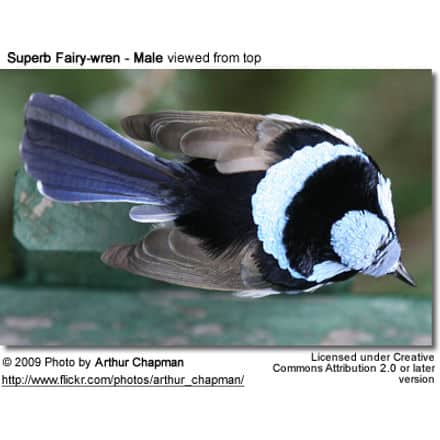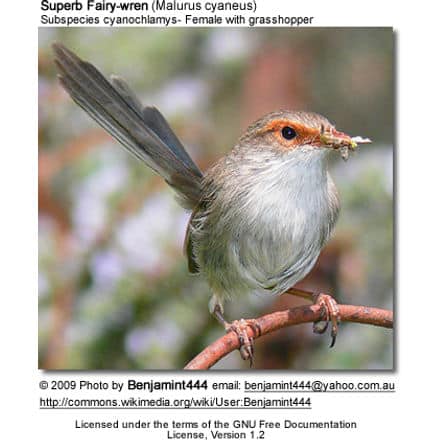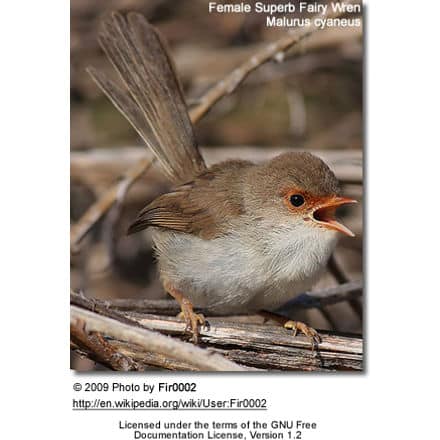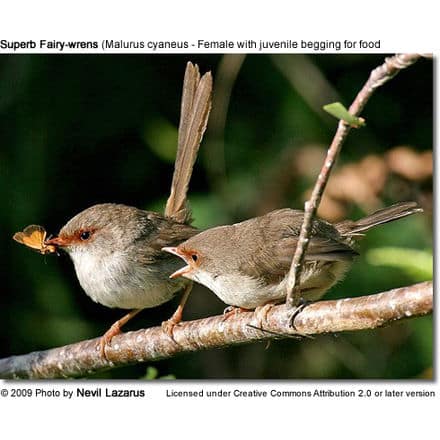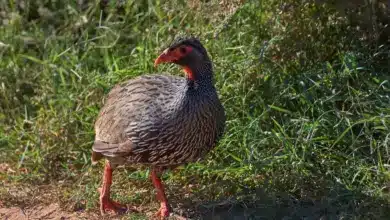Superb Fairy-wrens
Superb Fairy-wrens (Malurus Cyaneus)
Fairy-wrens
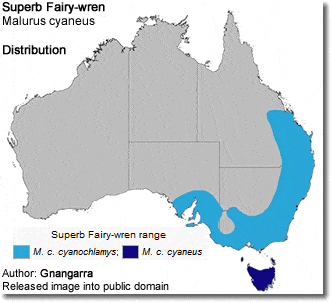
Superb Fairy-wrens occupy a wide range of habitat types and are found in almost any area that has at least a little dense undergrowth for them to shelter in, including grasslands with scattered shrubs, moderately thick forest, woodland, heaths, and domestic gardens.
Distribution
The Superb Fairy-wren is common throughout most of the relatively wet and fertile south-eastern corner of the continent, from the south-east of South Australia (including Kangaroo Island and Adelaide) and the tip of the Eyre Peninsula, through all of Victoria, Tasmania, coastal and sub-coastal New South Wales and Queensland, through the Brisbane area and extending inland – north to the Dawson River and west to Blackall; it is a common bird in the suburbs of Sydney, Melbourne and Canberra.
It is found in wooded areas, generally with plenty of undergrowth, and has also adapted to urban existence and can be found in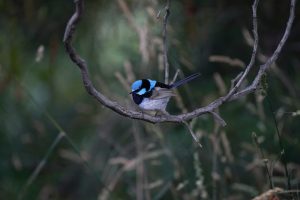
Unlike other fairy wrens, it appears to benefit from the urban environment and has out-competed the introduced House Sparrow (Passer domesticus) in one study on the grounds of the Australian National University in Canberra.] Colonies of wrens can be found in Hyde Park and the Royal Botanic Gardens in Sydney’s urbanized centre. It is not found in dense forests or alpine environments. Forestry plantations of pine (Pinus spp.) and eucalypts are also unsuitable as they lack undergrowth.
Description
The Superb Fairy-wren is 14 cm (5.5 in) long and weighs 8–13 g (0.28–0.46 oz), with males on average slightly larger
than females. The average tail length is 5.9 cm (2? in), among the shortest in the genus.
Averaging 9 mm (0.4 in) in subspecies cyaneus and 8 mm (0.3 in) in subspecies cyanochlamys, the bill is relatively
long, narrow pointed, and wider at the base. Wider than it is deep, the bill is similar in shape to those of other birds that feed by probing for or picking insects off their environs.
Like other fairy-wrens, the Superb Fairy-wren is notable for its marked sexual dimorphism (visual physical differences between the sexes), males adopting a highly visible breeding plumage of brilliant iridescent blue contrasting with black and grey-brown. The brightly colored crown and ear tufts are prominently featured in breeding displays.
The breeding male has a bright blue forehead, ear coverts, mantle and tail, brown wings, and black throat, eye band, breast, and bill.
Females, immatures, and non-breeding males are a plain fawn color with a lighter underbelly and a fawn (females and immatures) or dull greyish blue (males) tail. The bill is brown in females and juveniles and black in males after their first winter. Immature males molt into breeding plumage the first breeding season after hatching, though incomplete molting sometimes leaves residual brownish plumage that takes another year or two to perfect.
Both sexes molt in autumn after breeding, with males assuming an eclipse of non-breeding plumage. They molt again into nuptial plumage in winter or spring.
Breeding males’ blue plumage, particularly the ear-coverts, is highly iridescent due to the flattened and twisted surface of the barbules. The blue plumage also reflects ultraviolet light strongly, and so may be even more prominent to other fairy wrens, whose color vision extends into this part of the spectrum.
Song / Vocalization
Vocal communication among Superb fairy-wrens is used primarily for communication between birds in a social group and advertising and defending a territory.
The basic, or Type I, song is a 1–4 second high-pitched reel consisting of 10–20 short elements per second; it is sung by both males and females. Males also possess a peculiar song-like Type II vocalization, which is given in response to the calls of predatory birds, commonly Grey Butcherbirds (Cracticus torquatus).
The purpose of this behavior, which does not elicit a response from other nearby wrens, remains unknown. It is not a warning call but gives away the location of the vocalizing male to the predator. It may serve to announce male fitness, but this is far from certain.
Superb Fairy-wrens’ alarm call is a series of brief sharp chits, universally given and understood by small birds in response to predators.
Females also emit a purr while incubating.
Diet / Feeding
Like all fairy-wrens, the Superb Fairy-wren is an active and restless feeder, particularly on open ground near the shelter, but also through the lower foliage. Movement is a series of jaunty hops and bounces, with its balance assisted by a proportionally large tail, which is usually held upright, and rarely still.
The diet is a wide range of small creatures, mostly insects, supplemented by small quantities of seeds, flowers, and fruit.
Nesting / Breeding
Another interesting habit of males of this and other fairy-wren species during the reproductive season is to pluck petals (in this species, yellow ones which contrast with their plumage) and show them to conspecifics (of, or belonging to, the same species) (Karubian and Alvarando 2003). The obvious conclusion would be that this is a form of courtship (when directed at females) and/or antagonistic behavior (when directed at other males). However, research, while suggesting a courtship rather than antagonistic function of this behavior, has failed to show a good correspondence between petal-carrying and mating success in the related Red-backed Fairy-wren. Notably, fairy-wrens are socially monogamous and sexually promiscuous: pairs will bond for a long time, but mate with other individuals.
Young are often raised not by the pair alone, but with other males who also mated with the pair’s female assisting. Thus, petal-carrying might be a behavior that strengthens the pair’s bond. Petal carrying might also be a way for extra males to gain matings with the female.
Copyright: Wikipedia. This article is licensed under the GNU Free Documentation License. It uses material from Wikipedia.org … Additional information and photos added by Avianweb.
Please Note: The articles or images on this page are the sole property of the authors or photographers. Please contact them directly with respect to any copyright or licensing questions. Thank you.

